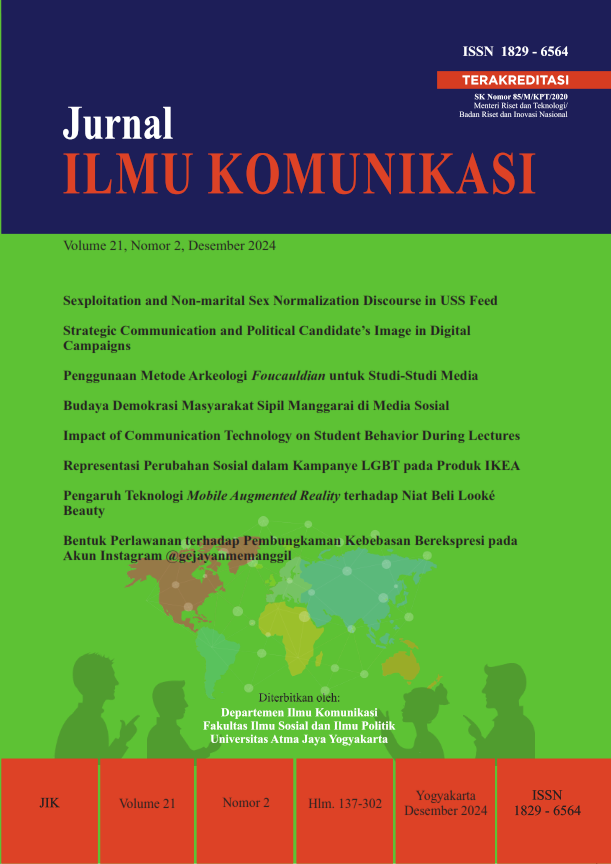Bentuk Perlawanan terhadap Pembungkaman Kebebasan Berekspresi pada Akun Instagram @gejayanmemanggil
DOI:
https://doi.org/10.24002/jik.v21i2.7620Keywords:
constructing a message, critical community @gejayanmemanggil, form of resistance, the removal of mural, van Dijk critical discourse modelAbstract
The removal of the mural as a critical message in the Instagram account prompted a critical community @gejayanmemanggil to hold a Lomba Mural Dibungkam. The purpose of this article is to provide a vital explanation of the form of resistance that causes the act of silencing freedom of opinion as well as the disclosure of motives in constructing a message about resistance. The method uses Van Dijk's critical discourse model with text, social cognition, and context dimensions. The results found that the form of resistance was carried out directly, indirectly, and virtually through social media and made the message viral.
References
@gejayanmemanggil. (2021). Aliansi rakyat bergerak. Instagram.com <https://www.instagram.com/gejayanmemanggil/?hl=en>
Al Habsy, M. H. (2022, January 4). Belajar dari fenomena “no viral no justice”. Detik.com. <https://news.detik.com/kolom/d-5883436/belajar-dari-fenomena-no-viral-no-justice>
Althusser, L. (2014). On the reproduction of capitalism: Ideology and ideological state apparatus (3rd ed.). London, UK: Verso Publishing.
Arianto, B. (2022). Melacak gerakan masyarakat sipil melalui tagar #reformasidikorupsi di Twitter. Jurnal Ilmu Komunikasi, 19(1), 51–67.
Badan Pusat Statistik. (2021, August 8). Indeks demokrasi indonesia (IDI) menurut indikator, 2018-2020. Bps.go.id. <https://www.bps.go.id/id/statistics-table/2/NjM4IzI=/indeks-demokrasi-indonesia--idi--menurut-indikator.html>
Barenbang Kemenaker. (2024, November 24). Menaker Ida: 29,12 juta orang penduduk usia kerja terdampak pandemi covid-19. Kementerian Ketenagakerjaan Republik Indonesia.
Kritik Jokowi. (2021, August 16). Kritik “jokowi 404:not found” berujung penghapusan mural: Mengapa kita tidak boleh protes?’. Bbc.com. <https://www.bbc.com/indonesia/indonesia-58220409>
Carr, C. T., & Hayes, R. A. (2015). Social media: defining, developing, and divining. Atlantic Journal of Communication, 23(1), 46–65.
Council of Europe. (2022). Working with the council of europe: A practical guide for civil society. Strasbourg, Prancis: Council of Europe
Denhardt, J. V., & Denhardt, R. B. (2015). The new public service revisited. Journal Public Administration Review, 75(5), 664–672.
Dewaweb Team. (2024, April 24). Error 404 not found: pengertian, penyebab, dan cara mengatasinya. Dewaweb.com. <https://www.dewaweb.com/blog/error-404-not-found-apa-maksudnya-dan-cara-mengatasinya/>
Dwiastono, R. (2023, May 9). 25 tahun pasca reformasi, kebebasan berpendapat di indonesia belum terjamin. Voaindonesia.com. <https://www.voaindonesia.com/a/tahun-pasca-reformasi-kebebasan-berpendapat-di-indonesia-belum-terjamin/7084186.html>
Eriyanto. (2017). Analisis wacana: Pengantar analisis teks media. Indonesia, Yogyakarta: LKIS.
Firdaus, M. (2021). Disparitas harga pangan strategis sebelum dan saat pandemi COVID-19. Jurnal Ekonomi Indonesia, 10(2), 107–120.
Haryatmoko. (2021). Critical discourse analysis (analisis wacana kritis): landasan teori, metodologi, dan penerapan. Indonesia, Jakarta : Raja Grafindo Perkasa.
Iswandi, H. (2016). Seni mural sebagai unsur politik dalam kehidupan sosial. Besaung: Jurnal Seni Desain Dan Budaya, 1(1), 9–14.
Laksana, D. A. W., & Adiwibawa, B. A. P. (2018). Mural dalam paparan media dan pembelajaran sosial bagi masyarakat kampung Kota. Demandia, 3(1), 46–56.
Littlejohn, S. W., Foss, K. A., & Oetzel, J. G. (2017). Theories of human communication (11th ed.). Long Grove Illinois, US : Waveland Press, Inc.
Mamahit, J. E., & Pratiwi, A. (2022). Instagram sebagai media alternatif dalam konflik agraria (studi kasus pada akun instagram @forumpancoranbersatu). Ekspresi Dan Persepsi: Jurnal Ilmu Komunikasi, 5(1), 191–200.
Manovich, L. (2002). The language of new media. Massachusetts, US : MIT Press.
PBB Sebut. (2023, April 5). PBB sebut staf perempuannya dilarang bekerja oleh Taliban. (2023, April 5). Dw.com. <https://www.dw.com/id/pbb-sebut-staf-perempuannya-dilarang-bekerja-oleh-taliban/a-65231841>
Pramana, G. I., & Irfansyah, A. (2019). Street art sebagai komunikasi politik: Seni, protes, dan memori politik. Jurnal Ilmiah Widya Sosiopolitika, 1(2), 98–108.
Prasanti, R. I. (2023). Perlawanan terselubung di tengah demokrasi (Studi kasus mural jalanan di kota solo dan yogyakarta). Journal of Politics and Government Studies, 12(1), 171–180.
Puddephatt, A. (2011). Mapping digital media: freedom of expression rights in the digital age. Opensocietyfoundations.org. <https://www.opensocietyfoundations.org/uploads/954441ed-1a7e-4d87-a517-47b61180a7c7/mapping-digital-media-freedom-expression-rights-20110728.pdf>
Reed, T. V. (2005). The art of protest: Culture and activism from the civil rights movement to the Streets of Seattle. Minneapolis, US : University of Minnesota Press.
Rozan, F. A., & Fransiscus, J. (2021). Demokrasi tapi kok dibatasi? Menyoal kritik dibalas represi. Gamapi.fisipol.ugm.ac.id. <https://gamapi.fisipol.ugm.ac.id/demokrasi-tapi-kok-dibatasi/
Sudrajat, D. (2021, August 21). Seniman grafiti pertanyakan kenapa mural kritikan dihapus aparat. Bogordaily.net. <https://bogordaily.net/2021/08/seniman-grafiti-pertanyakan-kenapa-mural-kritikan-dihapus-aparat/>
Taprial, V., & Kanwar, P. (2012). Understanding Social Media. India, India : Ventus Publishing Aps.
White, A. (2014). Digital media and society: transforming economics, politics, and social practices (1st ed.). London, UK: Palgrave Mcmillan.
Yendra, Y., Septia, E., & Dwinitia, S. (2022). The re-existence of murals as a medium of criticism in the modern digital era. Curricula: Journal of Teaching and Leaning, 7(1), 30–36.
Yohana, M. F. (2021). Mural sebagai media penyampai pesan sosial bagi masyarakat dalam perspektif semiotika charles sanders pierce. Jurnal Ilmu Komunikasi: Gandiwa, 01(02), 2798–5180.
Downloads
Published
How to Cite
Issue
Section
License

This work is licensed under a Creative Commons Attribution 4.0 International License.
Jurnal ILMU KOMUNIKASI is an academic journal. As such, it is dedicated to the open exchange of information. For this reason, JIK is freely available to individuals and institutions. Authors who publish in Jurnal ILMU KOMUNIKASI will release their articles under the Creative Commons Attribution (BY) License. This license allows anyone to copy and redistribute the article in any medium or format as well as remix, transform, and build upon the material for any purpose, even commercially as long as they credit the authors for the original creation. For details of the rights authors grants users of their work, see the "human-readable summary" of the license, with a link to the full license. (Note that "you" refers to a user, not an author, in the summary)
 This work is licensed under a Creative Commons Attribution 4.0 International License.
This work is licensed under a Creative Commons Attribution 4.0 International License.














